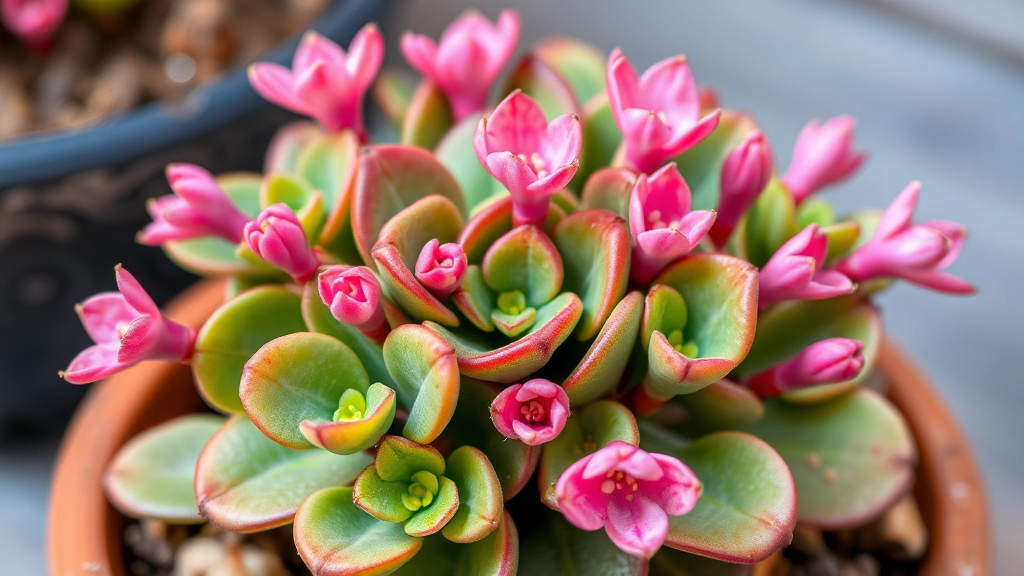Kalanchoe: The Resilient Succulent
If you’re into gardening, you’ve likely heard about the succulent plant Kalanchoe. This resilient and eye-catching plant is perfect for both beginners and seasoned green thumbs. Whether you’re looking to add some greenery to your home or want a low-maintenance plant, Kalanchoe is a fantastic choice.
Guide Overview
In this guide, I’ll walk you through the essential steps for creating points about the succulent plant Kalanchoe. From understanding its unique features to mastering its care, you’ll have all the information you need to keep your Kalanchoe thriving. So, let’s dive in and explore the world of this stunning succulent.
Are you looking for a vibrant and resilient addition to your indoor garden? Kalanchoe succulent plants might be just what you need.
These charming plants are known for their fleshy leaves and stunning flowers, making them a popular choice among both novice and experienced gardeners.
## What Makes Kalanchoe Special?
Kalanchoe belongs to the Crassulaceae family and is native to Madagascar.
Their ability to store water in their leaves allows them to thrive in arid conditions, which is a significant advantage for busy individuals who may forget to water regularly.
## Key Features
– **Diverse Varieties**: Kalanchoe comes in various shapes, sizes, and colours, offering something for everyone.
– **Low Maintenance**: These plants are relatively easy to care for, making them ideal for those new to gardening.
– **Long Blooming Period**: Many Kalanchoe varieties produce vibrant flowers that can last for weeks, adding a splash of colour to your home.
For those interested in specific varieties, you might find the [Kalanchoe Mother of Thousands Care, Propagation, and Flowering](https://planthq.org/kalanchoe-mother-of-thousands-care-propagation-and-flowering/) guide particularly useful. Additionally, if you have a Kalanchoe that isn’t flowering, there are some great tips and solutions in the [Why Is My Kalanchoe Not Flowering? Top Reasons and Fixes](https://planthq.org/why-is-my-kalanchoe-not-flowering-top-reasons-and-fixes/) article.
Types of Kalanchoe Varieties
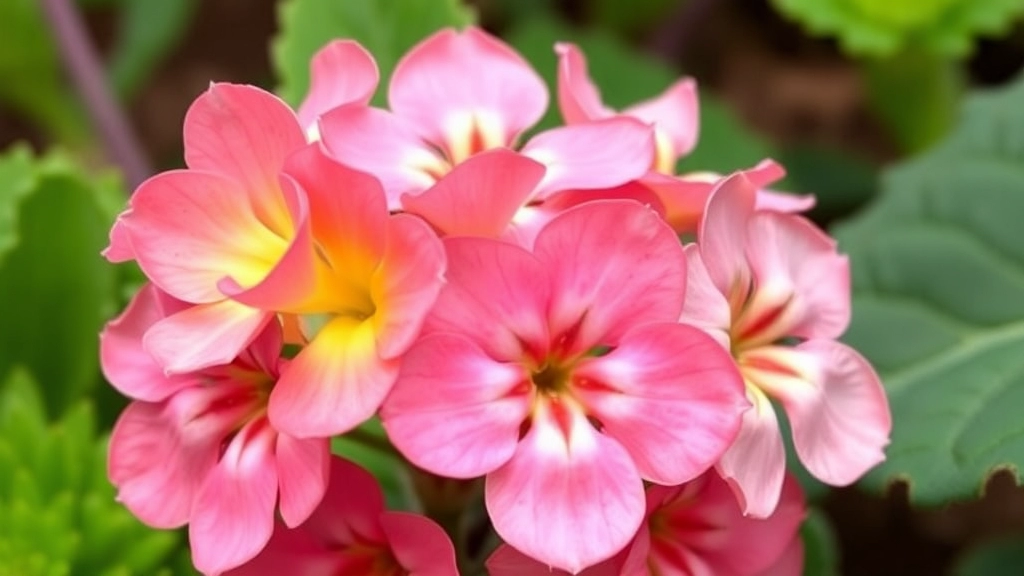
When diving into the world of Kalanchoe, you might be wondering, “Which variety is best for me?”
Let’s explore the delightful range of Kalanchoe varieties that can brighten up your home or garden.
Popular Kalanchoe Varieties
- Kalanchoe Blossfeldiana
- Known for its vibrant clusters of flowers.
- Blooms in various colours like pink, red, and yellow.
- Perfect for adding a splash of colour indoors.
- Kalanchoe Tomentosa (Panda Plant)
- Features fuzzy, silvery leaves with brown edges.
- A quirky choice that’s both charming and low-maintenance.
- Great for those who love a unique look.
- Kalanchoe Luciae (Flapjack Plant)
- Known for its large, flat leaves that resemble pancakes.
- The leaves turn a stunning red in bright light.
- An eye-catching addition to any succulent collection.
- Kalanchoe Daigremontiana (Mother of Thousands)
- Famous for producing tiny plantlets along its edges.
- A bit of a spreader, so be ready to manage its growth!
- Ideal for those who love propagation.
- Kalanchoe Fedtschenkoi (Paddle Plant)
- Features thick, paddle-shaped leaves with a slight blue hue.
- A favourite for those who appreciate a more sculptural look.
- Thrives in sunny spots, making it a great indoor companion.
Why Choose Kalanchoe?
Kalanchoe varieties are not just about aesthetics; they also come with various care requirements, making it essential to pick the right one for your lifestyle.
- Ease of Care: Most varieties are forgiving and perfect for beginners.
- Versatility: They can thrive indoors or outdoors, depending on the variety.
- Blooms: Some varieties bloom frequently, adding seasonal joy to your space.
Ideal Growing Conditions for Kalanchoe
Understanding the ideal growing conditions for Kalanchoe is crucial for ensuring these beautiful succulents thrive in your care.
What Do Kalanchoe Need to Flourish?
Kalanchoe plants are resilient, but they do have specific preferences that can make a significant difference in their growth. Here are the key factors to consider:
- Light: Kalanchoe thrives in bright, indirect sunlight. A south or west-facing window is ideal. Too much direct sunlight can scorch the leaves, while insufficient light can hinder blooming.
- Temperature: These plants prefer a warm environment, ideally between 15°C to 25°C. They can tolerate slightly cooler temperatures, but avoid frost as it can damage them.
- Humidity: Kalanchoe does well in average humidity levels. They are not particularly fond of high humidity, which can lead to rot.
- Air Circulation: Good air circulation is essential. This helps prevent fungal issues and keeps the plant healthy.
- Potting: Choose a pot with drainage holes to prevent waterlogging. A terracotta pot is a great option as it allows for airflow and moisture regulation.
By providing these ideal conditions, you can create a thriving environment for your Kalanchoe plants. For more detailed guidance, check out our Ultimate Guide to Growing and Caring for Succulent Plant Kalanchoe and our tips on Optimal Sunlight for Thriving Kalanchoe Plants.
Watering Needs and Schedules
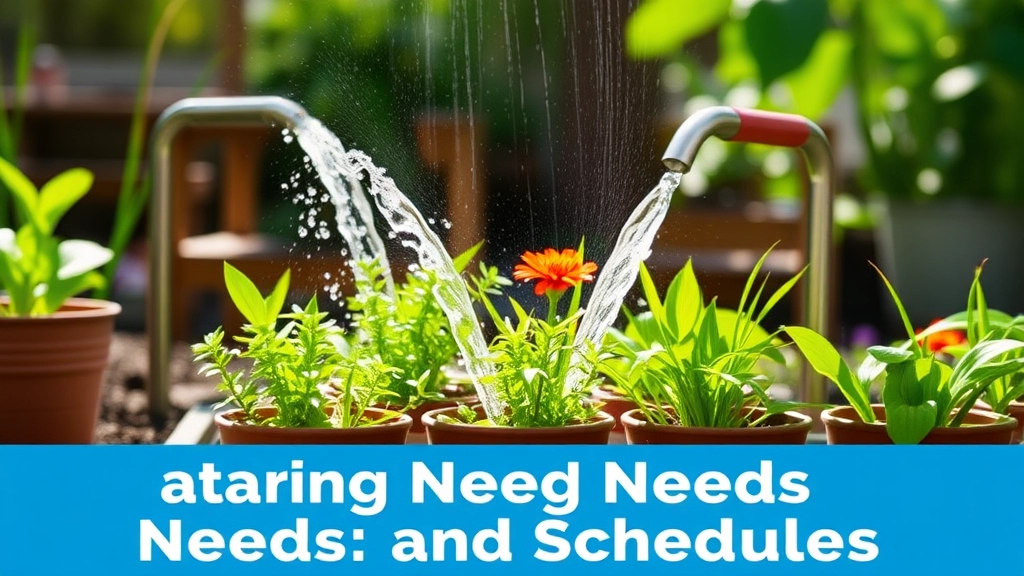
Understanding the watering needs of Kalanchoe succulent plants is crucial for their health and vitality. Many enthusiasts often wonder, “How much water does my Kalanchoe really need?” or “What’s the best schedule for watering?”
Watering Guidelines
Kalanchoe plants thrive on a specific watering routine. Here’s a simple guide to keep your succulent happy:
- Frequency: Water every 2-3 weeks during the growing season (spring and summer).
- Check Moisture: Always check the top inch of soil. If it’s dry, it’s time to water.
- Winter Care: Reduce watering in the winter months to once a month, as the plant enters a dormant phase.
Watering Techniques
When watering your Kalanchoe, consider these methods:
- Deep Watering: Ensure water reaches the roots. Water thoroughly until it drains from the bottom.
- Avoid Overwatering: Kalanchoes are sensitive to soggy soil. Always let the pot drain completely.
- Use Room Temperature Water: Cold water can shock the plant.
Signs of Improper Watering
Keep an eye out for these signs that indicate your watering routine may need adjustment:
- Overwatering: Yellowing leaves or mushy stems.
- Underwatering: Wrinkled leaves or a drooping appearance.
When it comes to cultivating Kalanchoe succulents, understanding soil and fertilization needs is vital for their health and growth. Many enthusiasts often wonder, “What type of soil is best for my Kalanchoe?” or “How do I properly fertilize these plants?”
### Soil Requirements
Kalanchoe thrives in well-draining soil, which is crucial to prevent root rot. Here are some essential tips for selecting the right soil:
– **Cactus or Succulent Mix**: Opt for a commercial cactus or succulent potting mix, as it typically contains the right balance of drainage and nutrients.
– **DIY Soil Mix**: If you prefer a homemade option, combine:
– 1 part potting soil
– 1 part coarse sand or perlite
– 1 part pumice or grit
This blend ensures excellent drainage while retaining some moisture.
### Fertilization Needs
Fertilizing your Kalanchoe is equally important, but it should be done judiciously. Here’s a straightforward approach:
– **Frequency**: Fertilize during the growing season (spring and summer) every 4-6 weeks.
– **Type**: Use a balanced, water-soluble fertilizer diluted to half strength. Look for one with an NPK ratio of 10-10-10 or similar.
– **During Dormancy**: Avoid fertilizing in autumn and winter, as the plant enters a dormant phase.
### Additional Tips
– **Signs of Over-Fertilization**: Watch for yellowing leaves or stunted growth, which may indicate excess nutrients.
– **Soil pH**: Kalanchoe prefers slightly acidic to neutral soil (pH 6.0 to 7.0). Testing your soil can help you maintain the right conditions.
For more detailed care instructions, you might find our [complete care guide for Kalanchoe Chocolate Soldier](https://planthq.org/complete-care-guide-for-kalanchoe-chocolate-soldier/) helpful. Additionally, if you are dealing with issues like yellowing leaves, our article on [why Kalanchoe bottom leaves turn yellow](https://planthq.org/why-kalanchoe-bottom-leaves-turn-yellow-causes-solutions/) provides valuable insights and solutions.
Common Pests and Diseases
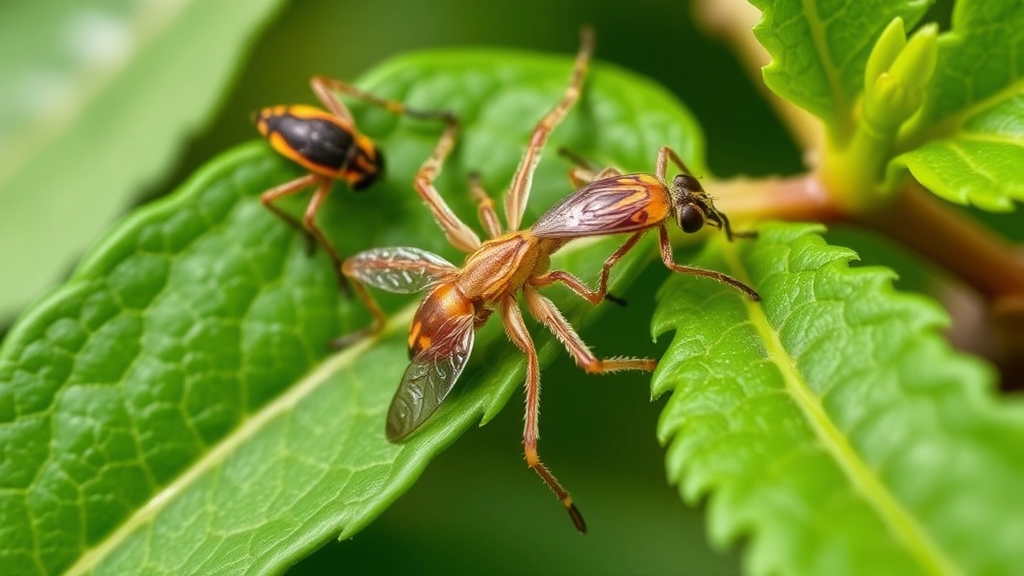
So, you’ve got your Kalanchoe thriving, but what happens when those pesky pests or diseases come knocking?
Worries We All Face:
- Why are the leaves turning yellow?
- What are those tiny bugs on my plant?
- How do I stop my Kalanchoe from wilting?
Let’s dive into the common culprits that can threaten your lovely Kalanchoe.
Common Pests
Mealybugs
These little white fluffballs suck the sap from your plant.
Look for them tucked in leaf joints or under leaves.
Tip: Wipe them off with a cotton swab dipped in rubbing alcohol.
Aphids
Tiny green or black bugs that can cluster on new growth.
They can distort leaves and stunt growth.
Tip: Spray with a mixture of water and dish soap to knock them off.
Spider Mites
Fine webbing on your plant? You might have these guys.
They thrive in dry conditions, so keep humidity in check.
Tip: Increase humidity or mist your plants to deter them.
Common Diseases
Root Rot
Caused by overwatering, leading to mushy roots.
Leaves may yellow and drop off.
Tip: Ensure proper drainage and let the soil dry out between waterings.
Powdery Mildew
A white, powdery substance on leaves.
It thrives in high humidity and poor air circulation.
Tip: Increase airflow and avoid overhead watering.
Leaf Spot
Dark spots on leaves can indicate fungal infections.
This often happens with excess moisture.
Tip: Remove affected leaves and ensure good drainage.
Quick Prevention Tips
- Inspect Regularly: Check your Kalanchoe often to catch issues early.
- Keep Clean: Remove dead leaves and debris from the pot.
- Rotate Your Plant: Helps ensure even light exposure, reducing stress.
Keeping an eye out for these pests and diseases can save your Kalanchoe from unnecessary stress.
Propagation Techniques for Kalanchoe
Having explored the essential care for Kalanchoe, it’s time to delve into the exciting world of propagation. Many enthusiasts wonder how to multiply their beloved Kalanchoe plants, and the good news is that it’s quite straightforward.
Common Propagation Methods
- Leaf Cuttings
– Select a healthy leaf from your Kalanchoe.
– Allow it to dry for a few days to form a callus.
– Place the leaf in well-draining soil, ensuring it’s slightly buried.
– Water sparingly until roots develop. For a detailed guide, check out our step-by-step guide on growing Kalanchoe from leaf cuttings. - Stem Cuttings
– Cut a healthy stem around 4-6 inches long.
– Remove the lower leaves and let the cutting dry for a day.
– Plant in soil, keeping it moist but not soggy.
– Roots should form in a few weeks. Learn more about the step-by-step propagation process. - Offsets and Pups
– Kalanchoe often produces small offshoots at the base.
– Gently separate these pups from the parent plant.
– Replant them in their own pots with well-draining soil.
– Water lightly until established.
Tips for Successful Propagation
- Timing Matters
– The best time to propagate is during the growing season (spring and summer).
– This ensures optimal growth and root development. - Use Clean Tools
– Always use sterilised scissors or knives to prevent disease.
– This simple step can save you from future headaches. - Humidity and Light
– After planting, keep the cuttings in a humid environment.
– Indirect sunlight is ideal until they establish roots. - Patience is Key
– Some cuttings may take longer to root than others.
– Keep an eye on them and resist the urge to overwater.
Pruning and Maintenance Tips for Kalanchoe
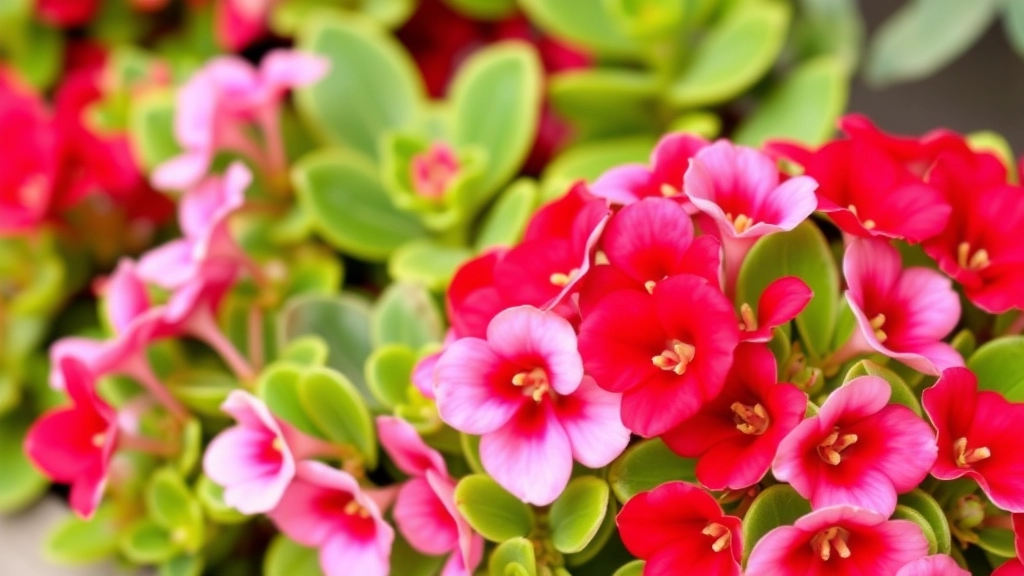
So, you’ve got your Kalanchoe thriving, but how do you keep it looking fresh and fabulous? Pruning and maintenance are key to ensuring your succulent not only survives but really flourishes.
Why Prune?
Pruning isn’t just for aesthetics; it helps your plant grow stronger. Here’s why you should consider it:
- Encourages New Growth: Snipping back old leaves can spur fresh ones.
- Prevents Overcrowding: A well-pruned plant has better airflow, which can reduce disease risk.
- Shapes the Plant: Keep your Kalanchoe looking its best with a tidy shape.
When to Prune
Timing is everything! The best time to prune your Kalanchoe is:
- After Blooming: Once those vibrant flowers fade, it’s time for a trim.
- Spring: This is when your plant is gearing up for growth, making it the perfect time to prune.
How to Prune
Here’s a step-by-step guide to make it easy:
- Gather Your Tools: Use clean, sharp scissors or pruning shears.
- Identify Dead or Dying Leaves: Look for any leaves that are brown or shrivelled.
- Cut at the Base: Snip the leaves close to the stem to avoid leaving stubs.
- Shape the Plant: If you want a certain look, trim back longer stems to encourage bushier growth.
Maintenance Tips
Keeping your Kalanchoe healthy doesn’t stop at pruning. Here are some simple maintenance tips:
- Dust the Leaves: Wipe them down with a damp cloth to keep them clean.
- Rotate the Plant: Give it a quarter turn every few weeks to ensure even sunlight exposure.
- Check for Pests: Regularly inspect for any unwanted visitors like mealybugs or aphids.
As we delve deeper into the care of Kalanchoe succulent plants, understanding their seasonal needs and blooming cycles can significantly enhance your gardening experience.
### Seasonal Care
Kalanchoe plants thrive with a bit of seasonal attention. Here are some key points to consider:
– **Spring**: This is the prime growing season. Increase watering as the temperatures rise and ensure they receive plenty of sunlight.
– **Summer**: While Kalanchoe enjoys warmth, be cautious of extreme heat. If temperatures soar above 30°C (86°F), consider providing some afternoon shade.
– **Autumn**: As temperatures begin to drop, reduce watering. This is also the time to prepare your plants for dormancy.
– **Winter**: Kalanchoe typically enters a resting phase. Water sparingly and keep them in a bright, cool location.
### Blooming Cycles
Kalanchoe plants are known for their vibrant flowers, which usually bloom in late winter to early spring. Here’s how to encourage blooming:
– **Light**: Ensure they receive bright, indirect sunlight. Too little light can hinder flowering.
– **Temperature**: Maintain a consistent temperature, ideally between 15-25°C (59-77°F).
– **Fertilization**: Use a balanced fertilizer during the growing season to promote healthy blooms.
### Additional Tips
– **Deadheading**: Regularly remove spent flowers to encourage new growth.
– **Stress for Blooms**: Some gardeners find that slightly stressing the plant (like reducing water) a few weeks before they want blooms can trigger flowering.
Understanding these seasonal care tips and blooming cycles will help your Kalanchoe not only survive but thrive. For more detailed information on specific varieties, check out our [top flowering Kalanchoe species and care tips](https://planthq.org/top-flowering-kalanchoe-species-and-care-tips/) or learn about [optimal sunlight for thriving Kalanchoe plants](https://planthq.org/optimal-sunlight-for-thriving-kalanchoe-plants/).
Decorative Uses and Arrangements for Kalanchoe Succulents
So, you’ve got your Kalanchoe succulent plants thriving, and now you’re wondering how to showcase them, right? Let’s dive into some creative ways to make these beauties shine in your home or garden.
Stunning Displays
Kalanchoe plants are not just pretty; they’re versatile too! Here’s how you can use them decoratively:
- Table Centrepieces: A cluster of Kalanchoe in varying heights and colours can transform your dining table.
- Window Sills: They love sunlight, so why not line your window sills with these vibrant plants?
- Hanging Baskets: Create a cascading effect with trailing varieties. They look fantastic hanging from hooks or shelves.
- Terrariums: Combine Kalanchoe with other succulents in glass containers for a mini desert scene.
Colour Coordination
Think about the colours you want to bring into your space. Kalanchoe comes in a range of hues, from bright pinks to deep reds. Here are some tips:
- Match with Room Decor: Pick Kalanchoe that complements your existing colour scheme.
- Seasonal Themes: Use pastel shades in spring and bold colours in autumn to reflect the season.
Grouping and Arrangement Tips
Grouping plants can create a stunning visual impact. Here’s how:
- Vary Heights: Use taller Kalanchoe at the back and shorter ones in front.
- Mix Textures: Pair Kalanchoe with other succulents or decorative stones for added interest.
- Use Unique Containers: Think outside the pot! Vintage teacups or wooden crates can add character.
Care Considerations
While making your arrangements, remember that Kalanchoe needs some TLC:
FAQs about Succulent Plant Kalanchoe
What are some popular Kalanchoe varieties?
Popular Kalanchoe varieties include:
- Kalanchoe Blossfeldiana: Known for its vibrant clusters of flowers in various colours like pink, red, and yellow.
- Kalanchoe Tomentosa (Panda Plant): Features fuzzy, silvery leaves with brown edges.
- Kalanchoe Luciae (Flapjack Plant): Known for its large, flat leaves that turn a stunning red in bright light.
- Kalanchoe Daigremontiana (Mother of Thousands): Famous for producing tiny plantlets along its edges.
- Kalanchoe Fedtschenkoi (Paddle Plant): Features thick, paddle-shaped leaves with a slight blue hue.
Why should I choose a Kalanchoe plant?
Kalanchoe plants are popular because they are:
- Easy to Care For: Most varieties are forgiving and perfect for beginners.
- Versatile: They can thrive indoors or outdoors, depending on the variety.
- Blooming: Some varieties bloom frequently, adding seasonal joy to your space.
How often should I water my Kalanchoe?
Kalanchoe plants should be watered every 2-3 weeks during the growing season (spring and summer). Always check the top inch of soil; if it’s dry, it’s time to water. Reduce watering in the winter months to once a month as the plant enters a dormant phase.
What are the signs of improper watering?
Signs of improper watering include:
- Overwatering: Yellowing leaves or mushy stems.
- Underwatering: Wrinkled leaves or a drooping appearance.
What are common pests that affect Kalanchoe plants?
Common pests include:
- Mealybugs: Look for white fluffballs tucked in leaf joints or under leaves.
- Aphids: Tiny green or black bugs that can cluster on new growth.
- Spider Mites: Indicated by fine webbing on your plant.
How can I prevent common diseases in Kalanchoe plants?
To prevent diseases like root rot, powdery mildew, and leaf spot:
- Ensure Proper Drainage: Avoid overwatering and let the soil dry out between waterings.
- Increase Airflow: Avoid high humidity and poor air circulation.
- Remove Affected Leaves: Regularly inspect and remove any diseased leaves.
When and how should I prune my Kalanchoe?
The best time to prune your Kalanchoe is after blooming or in the spring. Use clean, sharp scissors or pruning shears to snip back old leaves and shape the plant. This encourages new growth and prevents overcrowding.
What are some maintenance tips for Kalanchoe plants?
To keep your Kalanchoe healthy:
- Dust the Leaves: Wipe them down with a damp cloth.
- Rotate the Plant: Give it a quarter turn every few weeks for even sunlight exposure.
- Check for Pests: Regularly inspect for pests like mealybugs or aphids.
References
-
The Spruce – Growing Kalanchoe Succulents
-
The Old Farmer’s Almanac – Kalanchoe
-
Gardening Know How – Kalanchoe Care
